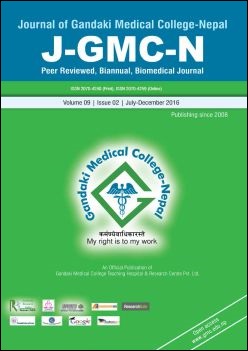Sleep Apnea
DOI:
https://doi.org/10.3126/jgmcn.v9i2.17863Keywords:
Apnea, Hypoxia, Obstructive sleep apnea, Polysomnography, SleepAbstract
Background: Sleep apnea is a condition that interrupts breathing while sleeping, usually caused by an obstruction blocking the back of the throat so that the air cannot reach the lungs. The brief cessation in breath automatically forces individuals to wake up and restart breathing. This can happen many times during the night, making it hard for the body to get enough oxygen, and impacts the sleep quality. It is the most common type of sleep disorder breathing.
Objectives: The present study was designed to investigate the effects of obstructive sleep apnea (OSA) on different mental, physical and nervous disorders which are manifested in such patients. This study would not only benefit in ascertaining the causes of OSA through assessment of higher mental functions of autonomic and peripheral nervous systems but also in the development of algorithm for estimation of degree of damage to the nervous system with severity of OSA.
Methods: A total of 1365 consecutive participants participated in this study at the Department of Pulmonary Medicine, Deccan College of Medical Sciences, Hyderabad, Telangana State, India for suspected sleep disordered breathing (SDB) between October 2012 and February 2016. In this cohort, 1140 participants were deemed ineligible, as per the inclusion criteria. Therefore, 225 patients were considered in the study along with 75 control subjects, who were healthy individuals. The cohort was diagnosed by an experienced pulmonologist for the symptoms of snoring and daytime somnolence. The data included documentation of age, gender, weight, height, BMI, waist and neck circumference, and clinical data such as history of apnea, insomnia, dyslipidemia, hypertension, and coronary heart disease. All participants underwent overnight polysomnography (PSG) in sleep laboratory. The cognitive function tests consisted of mini-mental state examination and by employing the depression questionnaire (Using Zung self report depression scale). The autonomic function tests were performed. Variabilities in heart rate were determined. Brain natriuretic peptide (BNP) levels in the blood were measured.
Results: The study group had an AHI ≥5 per hour of sleep while the control group had AHI <5 per hour of sleep. Overall, patients in the OSA cohort were older compared to those in the Control cohort. The overnight polysomnography values indicated distinct differences among the parameters of the analysis depending upon the category of the patient (i.e., mild, moderate and severe). Oxygen saturation in blood during both REM and NREM sleep stages clearly indicated lower oxygen in patient cohort than the control group. The cognitive function tests revealed that in comparison to the control group, OSA patients had significantly impaired cognition. OSA patients had significantly higher (p ≤0.05) depression. Motor action, muscle action potential and nerve action potential was significantly lower (p ≤0.05) than that of the control group of healthy patients. The plasma BNP in OSA patients was significantly higher (p ≤0.05) than control subjects. RR intervals in the patient group were significantly shorter than in the control group. The blood pressure of the OSA patients in general was relatively higher than the control group, both during the postural response and in handgrip test.
Conclusions: Among the enrolled individuals, those with severe OSA were affected in all faculties, namely, cognitive abilities and health attributes; and had high BNP levels in their blood. In aggregate, OSA patients can be alleviated from the syndrome, if accurate diagnosis is made on time. This study developed an algorithm which would aid the clinicians in early detection of OSA symptoms and mitigate the prognosis of the syndrome.
Journal of Gandaki Medical College
Volume, 09, Number 2, July December 2016, 29-37
Downloads
Downloads
Published
How to Cite
Issue
Section
License
This license allows reusers to distribute, remix, adapt, and build upon the material in any medium or format for noncommercial purposes only, and only so long as attribution is given to the creator.




